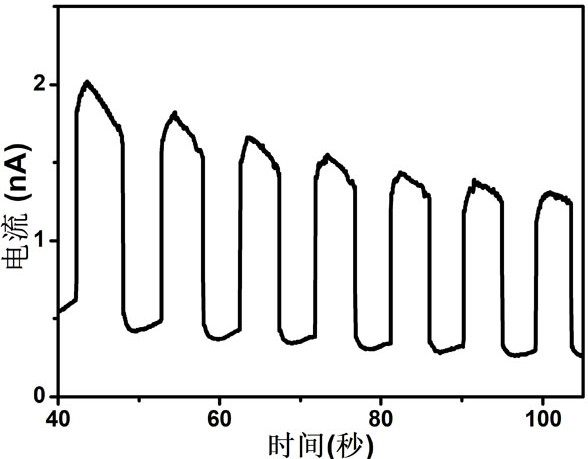Method for constructing high-sensitivity photoelectric detector based on C60 nanorods/ZnO quantum dots
A photodetector, high-sensitivity technology, applied in the field of photodetectors, can solve the problems of weak visible light absorbance, difficulty in controlling speed, difficulty in one-dimensional C60 materials, etc.
- Summary
- Abstract
- Description
- Claims
- Application Information
AI Technical Summary
Problems solved by technology
Method used
Image
Examples
Embodiment 1
[0027] A C-based 60 High-sensitivity photodetectors based on nanorods / ZnO quantum dots synthesized by an optimized solution-interface molecular self-assembly process for high-quality C 60 Nanorods are evenly distributed on any substrate by spin coating or drop coating, and ZnO quantum dots prepared by atomic layer deposition are introduced to enhance the light absorption ability and photoelectric conversion efficiency of the entire photoactive layer. 60 The high-sensitivity photodetector of nanorods / ZnO quantum dots is constructed according to the following steps:
[0028] 1) Put C 60 The powder was dissolved in chlorobenzene to make C 60 Chlorobenzene solution of the powder, and ultrasonically dispersed for 8-12 minutes to obtain C 60 Concentration range of 0.9mg / mL of C 60 The chlorobenzene solution A;
[0029] 2) Slowly and evenly add 7mL of isopropanol to 3mL of the solution A treated in step 1) through a dropper to obtain a brown precipitate. The resulting suspension ...
Embodiment 2
[0036] A C-based 60 The high-sensitivity photodetector of nanorod / ZnO quantum dot is similar to the step of embodiment 1, and is constructed according to the following steps:
[0037] 1) Add appropriate amount of C 60 The powder was dissolved in a certain amount of chlorobenzene, and ultrasonically dispersed for 8 to 12 minutes to obtain C with a concentration of 0.7 mg / mL. 60 The chlorobenzene solution A;
[0038] 2) Take the solution A, slowly and uniformly drop 9mL of isopropanol into 4mL of the C solution with a dropper. 60 In the chlorobenzene solution A, a brown precipitate was obtained, which was left to stand for 1 to 2 minutes after the dropwise addition, and then the obtained suspension was centrifuged to collect the precipitate, and the sample was washed 2 to 3 times by isopropanol centrifugation, and the washed sample The brown precipitate was dispersed in isopropanol and preserved, that is, C dispersed in isopropanol was obtained. 60 Nano stave;
[0039] 3) T...
Embodiment 3
[0044] A C-based 60 The high-sensitivity photodetector of nanorod / ZnO quantum dot is similar to the step of embodiment 1, and is constructed according to the following steps:
[0045] 1) Add appropriate amount of C 60 The powder was dissolved in a certain amount of chlorobenzene, and ultrasonically dispersed for 8 to 12 minutes to obtain C with a concentration of 1.2 mg / mL. 60 The chlorobenzene solution A;
[0046] 2) Slowly and evenly drop 6mL of isopropanol into 2mL of the C with a dropper 60 In the chlorobenzene solution A, a brown precipitate was obtained, which was left to stand for 1 to 2 minutes after the dropwise addition, and then the obtained suspension was centrifuged to collect the precipitate, and the sample was washed 2 to 3 times by isopropanol centrifugation, and the washed sample The brown precipitate was dispersed in isopropanol and preserved, that is, C dispersed in isopropanol was obtained. 60 Nano stave;
[0047] 3) ) the step 2) obtained C 60 The na...
PUM
| Property | Measurement | Unit |
|---|---|---|
| Wavelength | aaaaa | aaaaa |
Abstract
Description
Claims
Application Information
 Login to View More
Login to View More - R&D
- Intellectual Property
- Life Sciences
- Materials
- Tech Scout
- Unparalleled Data Quality
- Higher Quality Content
- 60% Fewer Hallucinations
Browse by: Latest US Patents, China's latest patents, Technical Efficacy Thesaurus, Application Domain, Technology Topic, Popular Technical Reports.
© 2025 PatSnap. All rights reserved.Legal|Privacy policy|Modern Slavery Act Transparency Statement|Sitemap|About US| Contact US: help@patsnap.com

